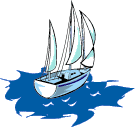

Goals:
1. To make students aware of the pollution that exists in the large bodies of water.
2. To allow students to identify sources of pollution within their own homes that may effect marine life.
3. To show students, that by writing people within the community and country, they can make a difference.
Resources:
1. Definitions of pollution causes taken from:
2. Other information about pollution and where pollution comes from taken from:
3. Movie- Sea Tek
Teacher Background:
Even though there are a lot of chemicals that do settle down at the bottom of the ocean, there are still many pollutants that take a long time to get settled. Many of the toxic chemicals that are in the environment are not only from big business, but also from store bought cleaning agents and solvents that humans dispose of improperly. The extent that these chemicals damage marine ecosystems and kill marine organisms is a complicated issue related to concentration of toxins, ocean currents, freshwater/seawater mixing, solubility, temperature, tolerance of the organisms, chemicals and many other factors. Regardless of all of the potential hazardous wastes, it is clear that the smaller amount of chemicals that we introduce to the ocean, the better the health will be with these various marine creatures. It is very important to educate students about the pollution in the air as well as the water.
Time: This lesson will take approximately three hours. One hour will be designated for the explanation of the different hazardous materials the students have come up with, One hour will be designated for explaining all of the different hazardous materials that are present within the home, and One hour will be designated to write a letter to a company that produces products like the ones that the students discovered at home.
Materials:
1. An assortment of labelled (empty) containers for potentially hazardous products (collected by the teacher).
2. Paper to write data about what the students discovered at home.
Procedure:
Part A:
Step 1- Review the labelling system for hazardous products. Ensure that the students understand the difference between: toxic or poisonous; flammable; reactive or explosive and corrosive materials, and the symbol shapes for poison, danger, warning, and caution.
Step 2- As a homework assignment, have the students search rooms in their house for these contaminants. Make sure that the students check their garage, basement, kitchen, bathroom and laundry room. As the students check out these places in their own homes, have them list the hazardous products or symbols that are on the labels. Students should consider all items such as deodorants, hair spray, shaving cream, air fresheners, oven cleaners, toilet bowl cleaners, drain cleaners, aerosols, window cleaners, laundry detergents, bleach, ammonia- based cleaners, abrasive cleaners, furniture polish, nail polish, spot removers, rug cleaners, motor oil, antifreeze, old batteries, paint, as well as all pesticides that are used on lawn or crops.
Step 3- From the list that the student gathers, have them choose one and investigate it further. Get the students to find out what the proper method of disposal is, and whether or not there are alternative products to use that are environmentally friendly.
Part B:
Have the students perform experiments in class that involve "homemade alternatives" to products that are not environmentally friendly. Have the students list their hypothesis as, "Brand X is just as effective as our homemade window cleaner that we made in class". The same types of cloth should be used for each experiment as well.
Some sample recipes include:
Window Cleaner (homemade): Mix white vinegar half and half with water.
Heavy Duty All Purpose Cleaner: Mix 50 ml household ammonia, 50 ml vinegar, 125 ml baking soda and 2 liters of warm water.
Scouring solution: Mix 125 ml baking soda and 125 ml of water.
Carpet Cleaner: sprinkle corn starch on a rug, leave for half an hour and then vacuum.
Air freshener: Boil cinnamon and cloves in water
Part C:
Tell the students to write a letter to a company that sells these hazardous products, asking them about their chemicals, and if they thought about alternatives to these chemicals. The letter will be mailed by the teacher to the different companies and all replies will be read to the class.
Part D:
Have the students watch the movie Sea Tek. This movie has actual footage of a whale that has been caught in an old fishing net out in the sea. It shows the actual rescue and the steps that had to be taken in order to try and get the whale free and revived. This film shows us that human negligence is also a lot of the cause with pollution.
Assessment:
Participation is a major part of this lesson and the students will be graded on whether or not they have completed the assignment. They also will be graded on the quality of their work. The letter that the student writes to the company of their choice will also be figured into the grading. The students will be assigned a letter grade for their results.
Curricular Strands and Major Concepts:
1. Science- By conducting experiments between the products students are seeing what these
chemicals do.
2. Communication Arts- Students will be doing these experiments in groups throughout the class.
3. Social Studies- Students will learn that society has a lot to do with the pollution that is in the water.
Possible Extensions:
1. Students could write another letter to a member of Congress or government to express how they feel about the pollution in the water system.
2. Develop a brochure that gives the results of classroom experiments.
3. Research the potential pollution chemicals that are in your school.

Back to Table of Contents
Back to Main Page